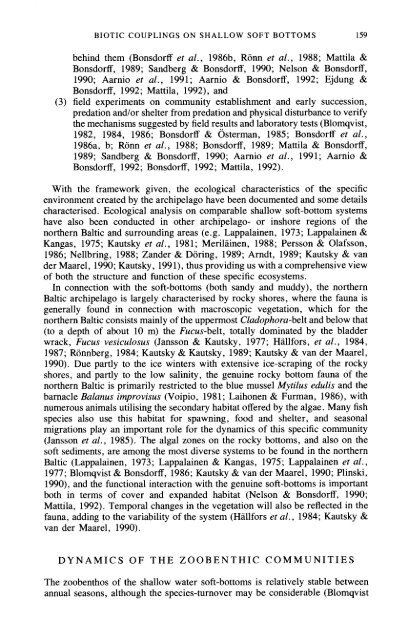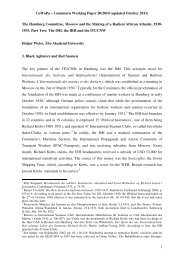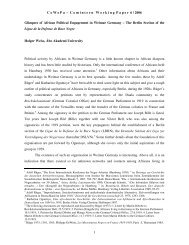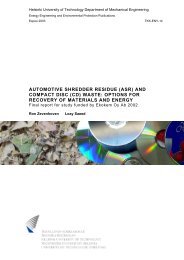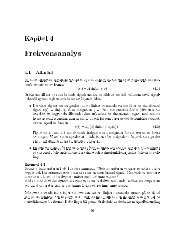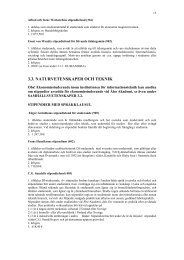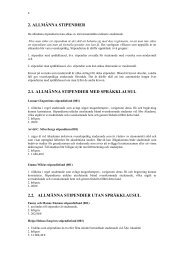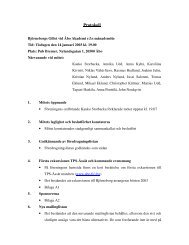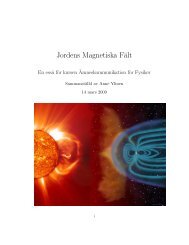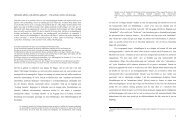biotic couplings on shallow water soft bottoms-examples from the ...
biotic couplings on shallow water soft bottoms-examples from the ...
biotic couplings on shallow water soft bottoms-examples from the ...
Create successful ePaper yourself
Turn your PDF publications into a flip-book with our unique Google optimized e-Paper software.
BIOTIC COUPLINGS ON SHALLOW SOFT BOTTOMS 159<br />
behind <strong>the</strong>m (B<strong>on</strong>sdorff et al., 1986b, R<strong>on</strong>n et al., 1988; Mattila &<br />
B<strong>on</strong>sdorff, 1989; Sandberg & B<strong>on</strong>sdorff, 1990; Nels<strong>on</strong> & B<strong>on</strong>sdorff,<br />
1990; Aarnio et al., 1991; Aarnio & B<strong>on</strong>sdorff, 1992; Ejdung &<br />
B<strong>on</strong>sdorff, 1992; Mattila, 1992), and<br />
(3) field experiments <strong>on</strong> community establishment and early successi<strong>on</strong>,<br />
predati<strong>on</strong> and/or shelter <strong>from</strong> predati<strong>on</strong> and physical disturbance to verify<br />
<strong>the</strong> mechanisms suggested by field results and laboratory tests (Blomqvist,<br />
1982, 1984, 1986; B<strong>on</strong>sdorff & ~sterman, 1985; B<strong>on</strong>sdorff et al.,<br />
1986a, b; R<strong>on</strong>n et al., 1988; B<strong>on</strong>sdorff, 1989; Mattila & B<strong>on</strong>sdorff,<br />
1989; Sandberg & B<strong>on</strong>sdorff, 1990; Aarnio et al., 1991; Aarnio &<br />
B<strong>on</strong>sdorff, 1992; B<strong>on</strong>sdorff, 1992; Mattila, 1992).<br />
With <strong>the</strong> framework given, <strong>the</strong> ecological characteristics of <strong>the</strong> specific<br />
envir<strong>on</strong>ment created by <strong>the</strong> archipelago have been documented and some details<br />
characterised. Ecological analysis <strong>on</strong> comparable <strong>shallow</strong> <strong>soft</strong>-bottom systems<br />
have also been c<strong>on</strong>ducted in o<strong>the</strong>r archipelago- or inshore regi<strong>on</strong>s of <strong>the</strong><br />
nor<strong>the</strong>rn Baltic and surrounding areas (e.g. Lappalainen, 1973; Lappalainen &<br />
Kangas, 1975; Kautsky et al., 1981; Merilainen, 1988; Perss<strong>on</strong> & Olafss<strong>on</strong>,<br />
1986; Nellbring, 1988; Zander & Doring, 1989; Arndt, 1989; Kautsky & van<br />
der Maarel, 1990; Kautsky, 1991), thus providing us with a comprehensive view<br />
of both <strong>the</strong> structure and functi<strong>on</strong> of <strong>the</strong>se specific ecosystems.<br />
In c<strong>on</strong>necti<strong>on</strong> with <strong>the</strong> <strong>soft</strong>-<strong>bottoms</strong> (both sandy and muddy), <strong>the</strong> nor<strong>the</strong>rn<br />
Baltic archipelago is largely characterised by rocky shores, where <strong>the</strong> fauna is<br />
generally found in c<strong>on</strong>necti<strong>on</strong> with macroscopic vegetati<strong>on</strong>, which for <strong>the</strong><br />
nor<strong>the</strong>rn Baltic c<strong>on</strong>sists mainly of <strong>the</strong> uppermost Cladophora-belt and below that<br />
(to a depth of about 10 m) <strong>the</strong> Fucus-belt, totally dominated by <strong>the</strong> bladder<br />
wrack, Fucus vesiculosus (Janss<strong>on</strong> & Kautsky, 1977; Hallfors, et al., 1984,<br />
1987; R<strong>on</strong>nberg, 1984; Kautsky & Kautsky, 1989; Kautsky & van der Maarel,<br />
1990). Due partly to <strong>the</strong> ice winters with extensive ice-scraping of <strong>the</strong> rocky<br />
shores, and partly to <strong>the</strong> low salinity, <strong>the</strong> genuine rocky bottom fauna of <strong>the</strong><br />
nor<strong>the</strong>rn Baltic is primarily restricted to <strong>the</strong> blue mussel Mytilus edulis and <strong>the</strong><br />
barnacle Balanus improvisus (Voipio, 198 1 ; Laih<strong>on</strong>en & Furman, l986), with<br />
numerous animals utilising <strong>the</strong> sec<strong>on</strong>dary habitat offered by <strong>the</strong> algae. Many fish<br />
species also use this habitat for spawning, food and shelter, and seas<strong>on</strong>al<br />
migrati<strong>on</strong>s play an important role for <strong>the</strong> dynamics of this specific community<br />
(Janss<strong>on</strong> et al., 1985). The algal z<strong>on</strong>es <strong>on</strong> <strong>the</strong> rocky <strong>bottoms</strong>, and also <strong>on</strong> <strong>the</strong><br />
<strong>soft</strong> sediments, are am<strong>on</strong>g <strong>the</strong> most diverse systems to be found in <strong>the</strong> nor<strong>the</strong>rn<br />
Baltic (Lappalainen, 1973; Lappalainen & Kangas, 1975; Lappalainen et al.,<br />
1977; Blomqvist & B<strong>on</strong>sdorff, 1986; Kautsky & van der Maarel, 1990; Plinski,<br />
1990), and <strong>the</strong> functi<strong>on</strong>al interacti<strong>on</strong> with <strong>the</strong> genuine <strong>soft</strong>-<strong>bottoms</strong> is important<br />
both in terms of cover and expanded habitat (Nels<strong>on</strong> & B<strong>on</strong>sdorff, 1990;<br />
Mattila, 1992). Temporal changes in <strong>the</strong> vegetati<strong>on</strong> will also be reflected in <strong>the</strong><br />
fauna, adding to <strong>the</strong> variability of <strong>the</strong> system (Hallfors et al., 1984; Kautsky &<br />
van der Maarel, 1990).<br />
DYNAMICS OF THE ZOOBENTHIC COMMUNITIES<br />
The zoobenthos of <strong>the</strong> <strong>shallow</strong> <strong>water</strong> <strong>soft</strong>-<strong>bottoms</strong> is relatively stable between<br />
annual seas<strong>on</strong>s, although <strong>the</strong> species-turnover may be c<strong>on</strong>siderable (Blomqvist


